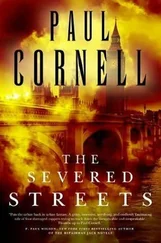Three weeks ago, Pellegrini and Landsman hit the Fish Man’s Whitelock Street apartment a second time, working through a search warrant that was written more for Pellegrini’s peace of mind than anything else. Months had passed and the chance of recovering any additional evidence from the apartment was minimal. Yet Pelligrini, now fixated on the store owner as his best suspect, was convinced that in their haste to hit the three-story shithouse on Newington back in February, they had blown off the earlier searches on Whitelock. In particular, Pellegrini vaguely remembered seeing a remnant of red carpeting in the Fish Man’s living room during the February raid; months later, he thought of the hairs and fibers taken from the young girl’s body at the morgue and recalled that one of those fibers was red cloth.
Red carpet, red fiber: Pellegrini suddenly had another reason to kick himself. For Pellegrini, the contents of file H88021 had become nothing less than an ever-changing landscape in which every tree, rock and bush seems to be moving. And it was no use explaining to him that this could happen to any detective on any case-this pit-of-the-stomach feeling that everything was being missed, that evidence was disappearing faster than an investigator could perceive it. Every detective in the unit had lived through the sensation of seeing something at a crime scene or during a search warrant and then looking twice to see that it was no longer there. Hell, maybe it never was there. Or maybe it’s still there, but now you’ve lost the ability to see it.
It was the stuff from which the Nightmare was made, the Nightmare being that recurring dream that occasionally ruins the sleep of every good detective. In the throes of the Nightmare, you are moving through the familiar confines of a rowhouse-you’ve got a warrant, perhaps, or maybe it’s just a plain-view search-and from the corner of your eye you glimpse something. What the hell is it? Something important, you know that. Something you need. A blood spatter. A shell casing. A child’s star-shaped earring. You can’t say for sure, but with every fiber of your being you understand that it’s your case lying there. Yet you look away for a moment, and when you look back again, it’s gone. It’s an empty place in your subconscious, a lost opportunity that mocks you. The Nightmare scares the hell out of young detectives; some of them even live the dream at their first crime scenes, convinced that the entire case is evaporating into the ether. As for the veterans, the Nightmare just pisses them off. They’ve gone through it enough not to believe every voice that speaks from the back of the mind.
And yet on this case the Nightmare owns Pellegrini. It ordered him to write the second warrant for the Fish Man’s apartment, it demanded that he collect enough probable cause to get back inside a door that had been opened to him once before. Not surprisingly, the September raid left the Fish Man as bored and indifferent as its predecessor. Nor did it produce a red cloth carpet fiber: Pellegrini found the remnant he remembered on the bedroom floor, but it proved to be plastic, an outdoor Astro-Turf carpet. Nor did a small blue pin earring found in a corner of the living room mean anything to the investigation. Contacted by detectives a few days later, Latonya Wallace’s family members explained that they never recalled the young girl wearing a mixed set of earrings. If she had a star-shaped pin in one lobe, it was safe to assume that a star-shaped pin was missing from the other. To be sure, Pellegrini borrowed a Cavalier and drove the blue pin earring up to the little girl’s mother; she seemed a little surprised that the case was still being worked after seven months, but confirmed that the blue earring did not belong to her daughter.
Around every corner of the maze, a fresh corridor began. A week after the second search of Whitelock Street, Pellegrini found himself tangled in a prolonged encounter with an auto thief arrested by Baltimore County police back in July. A disturbed young man with a history of mental illness, the thief had attempted suicide at the county detention center on three separate occasions, then blurted out to a county officer that he knew who had committed two murders in the city. One was a drug killing at a Northwest Baltimore bar. The other involved the death of a little girl in Reservoir Hill.
Howard Corbin went out to the county for the initial interview and came back with a story about a chance encounter in the alley behind the 800 block of Newington, where the auto thief said he had been snorting cocaine with his cousin. A little girl happened by the alley and the auto thief heard his cousin say something to the child. The girl-who carried a bookbag and wore her hair braided-said something back, and it seemed to the auto thief that they knew each other. But when his cousin jumped up and grabbed the girl, the auto thief became frightened and fled. Shown a picture of Latonya Wallace, the young man began crying.
Slowly, the scenario took on real life. The auto thief did indeed have a cousin at 820 Newington and the cousin did indeed have a substantial record, though nothing on it screamed sex offender. Still, Corbin was impressed that the young man had apparently remembered that the girl had her hair up in braids and was carrying a satchel. Those details had been released to the public early in the investigation, of course, but they helped establish some credibility for the thief ’s story.
Pellegrini and Corbin dutifully rechecked the vacant rowhouses in the 800 block of Newington and then towed a derelict Chevy Nova from the rear of an occupied house in that same block. The car had once belonged to the thief’s cousin, and the thief claimed that his relative routinely kept a buck knife and a switchblade in the trunk of the car. That car and another vehicle belonging to the cousin’s sister were both processed by lab techs at headquarters with negative results. Likewise, the auto thief was brought downtown for lengthy interviews.
Eventually, as facts began to get in his way, the thief’s story changed. He suddenly remembered, for instance, that his cousin had at one point opened the trunk of his sister’s car and shown him a zippered plastic bag. And then his cousin opened the zipper to reveal the face of the little girl. And then…
The auto thief was a mental case, no question about it. But his tale had been constructed with just enough detail to require a full investigation. The cousin would have to be confronted, and the story would have to be corroborated or knocked down. Eventually, the auto thief would have to be polygraphed.
Beyond that piece of business, Pellegrini also had another manila file on his desk with the name of a Park Avenue man on the heading-a raw mix of fact and rumor regarding a potential suspect known to have behaved strangely in recent months and on one occasion to have exposed himself to a schoolgirl. There were a few rape reports from the Central, too, along with notes from another five or six interviews with friends and former friends of the Fish Man.
All of that waits for Pellegrini as he pauses to work the shotgun murder of Theodore Johnson on Durham Street. And when that pause is over, he continues to wonder whether he should have kept working the drug killing rather than returning to obsess over Latonya Wallace. He tells himself that if he works the Durham Street murder hard, it might just go down. On the other hand, if he keeps on the dead little girl, there could be no telling when the case might break.
To every other detective on the shift, this is the worst kind of optimism. Latonya Wallace is history; Theodore Johnson is fresh. And in the minds of most of his colleagues, Pellegrini has gone over the hill on this one. Repeat warrants on a suspect’s apartment, prolonged background investigations, protracted statements from suicidal shitbirds-all of it is understandable of a young detective, they concede. Hell, with a dead little girl it may even be required, in a way. But, they tell each other, let’s not kid ourselves: Tom Pellegrini has lost it.
Читать дальше












